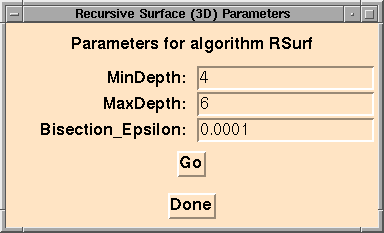Up to Pisces Online Documentation
Recursive Surface Algorithm
( also known as "RSurf" )
Overview
This algorithm approximates the zero level set of a function of three
variables. That is, given a function from R^3->R, this algorithm
computes the level set of zero associated to that function.
How Recursive Surface Works
The basic step of RSurf is to subdivide a cube into eight smaller cubes.
The initial cube is the bounding domain. The algorithm starts by replacing
the initial cube and all that result until all the cubes have some minimum
required depth. A cube's depth is the depth it has in the octree that
results from the cube replacement. The algorithm continues by subdividing
when a cube has not reached the maximum allowed depth and, the eight numbers
that result when you evaluated the function at the vertices of the cube do
not have the same sign.
Once a cube has reached its maximum depth, a polygonal approximation to the
surface is made by:
- Start at the first edge with a sign crossing.
- Look up which edges can be next based on what the current
edge is and its orientation.
- Decide which of these three edges have the sign crossing.
- Continue until back to the first edge.
- The polygon is then made up of the traversed edges crossings.
The algorithm is currently implemented recursively.
Controlling the algorithm from Pisces

The Pisces panel to the RSurf algorithm has 3 parameters:
- MinDepth:
All cubes are divided until they have at least minimum depth.
Example: If MinDepth is 3, then the original cube
(the bounding
domain) is divided into 8 cubes, each of the 8 into 8 cubes, and
each of the resulting 64 into 8 cubes resulting in 512 cubes
filling the original bounding domain.
Default Value: 4
- MaxDepth: No cubes are allowed to have depth greater than the maximum
depth.
Example: If the MaxDepth is 5, then if a cube has depth 5 it
will not be subdivided any further, but rather a polygonal approximation
to the surface will result instead.
Default Value: 6
- Bisection_Epsilon:
When bisecting the edge of a cube to find out where
the surface crosses the edge, the bisection process stops on an
interval of Bisection_Epsilon.
Default Value: 0.0001
Known Bugs
A memory allocation error will cause Pisces to crash.
This is currently being looked at.
Bug Reports
software@geom.umn.edu
Algorithm Implemented by
Daniel B. Krech
Acknowledgements
The algorithm was inspired after working on implementing a brute force
method for finding curves in the plane. The method involved dividing each
"scan line" up into n segments,
doing bisection on any segment where the
functions sign changed and drawing the pixel that results from the
bisection.
![[Pisces]](../../pix/pi.gif) The Pisces Home Page
The Pisces Home Page
![[HOME]](/pix/home.gif) The Geometry Center Home Page
The Geometry Center Home Page
Comments to: pisces@geom.umn.edu
Created Mon May 15 10:00:03 CDT 1995 by Dan Krech
Converted to html on July 26, 1995 by Erik Streed
Last Modified: July 26, 1995
Copyright © 1995 by
The Geometry Center,
all rights reserved.


![[Pisces]](../../pix/pi.gif) The Pisces Home Page
The Pisces Home Page